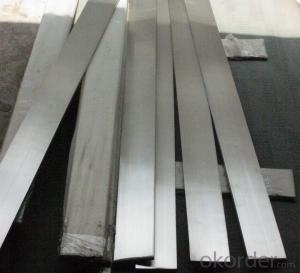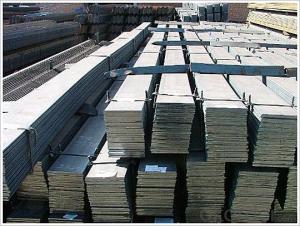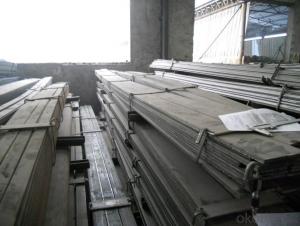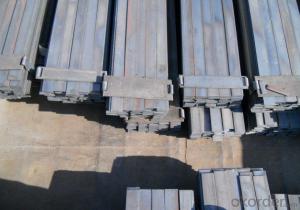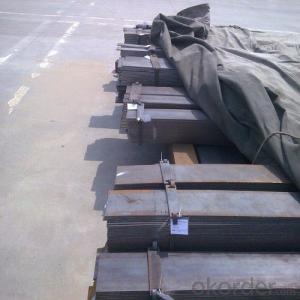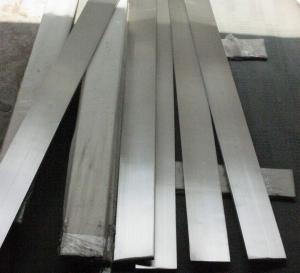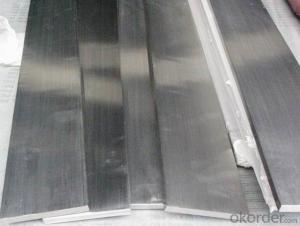Flat Steel A36 Q235 SS400 Slit Ms Carbon Mild Hot Rolled
- Loading Port:
- Tianjin
- Payment Terms:
- TT or LC
- Min Order Qty:
- 27 m.t.
- Supply Capability:
- 35000 m.t./month
OKorder Service Pledge
OKorder Financial Service
You Might Also Like
Product Description:
OKorder is offering Flat Steel A36 Q235 SS400 Slit Ms Carbon Mild Hot Rolled at great prices with worldwide shipping. Our supplier is a world-class manufacturer of steel, with our products utilized the world over. OKorder annually supplies products to European, North American and Asian markets. We provide quotations within 24 hours of receiving an inquiry and guarantee competitive prices.
Product Applications:
Flat Steel A36 Q235 SS400 Slit Ms Carbon Mild Hot Rolled are ideal for structural applications and are widely used in the construction of buildings and bridges, and the manufacturing, petrochemical, and transportation industries.
Product Advantages:
OKorder's Flat Steel A36 Q235 SS400 Slit Ms Carbon Mild Hot Rolled are durable, strong, and resist corrosion.
Main Product Features:
· Premium quality
· Prompt delivery & seaworthy packing (30 days after receiving deposit)
· Corrosion resistance
· Can be recycled and reused
· Mill test certification
· Professional Service
· Competitive pricing
Product Specifications:
Flat Steel
1.Thickness:1.5mm-14mm
2.Width:10mm-1010mm
3.Grade:Q235, Q345, A36
3.Factory producing, guaranteed material
| Flat Steel | |||
Width (mm) | Thickness (mm) | Length (m) | Theoretical Weight (kg/m) |
| 20 | 2.0 | 6/9/12 | 0.31 |
| 20 | 2.5 | 6/9/12 | 0.39 |
| 20 | 2.75 | 6/9/12 | 0.43 |
| 25 | 2.5 | 6/9/12 | 0.49 |
| 25 | 3.75 | 6/9/12 | 0.74 |
| 30 | 2.5 | 6/9/12 | 0.59 |
| 30 | 3.5 | 6/9/12 | 0.82 |
| 30 | 9.75 | 6/9/12 | 2.30 |
| 40 | 3.5 | 6/9/12 | 1.10 |
| 40 | 4.75 | 6/9/12 | 1.50 |
| 40 | 11.75 | 6/9/12 | 3.69 |
| 50 | 2.75 | 6/9/12 | 1.08 |
| 50 | 4.5 | 6/9/12 | 1.77 |
| 50 | 9.75 | 6/9/12 | 3.83 |
| 60 | 5.5 | 6/9/12 | 2.60 |
| 60 | 7.5 | 6/9/12 | 3.53 |
| 60 | 11.5 | 6/9/12 | 5.42 |
| 80 | 5.5 | 6/9/12 | 3.45 |
| 80 | 7.5 | 6/9/12 | 4.71 |
| 80 | 11.75 | 6/9/12 | 7.38 |
| 100 | 3.25 | 6/9/12 | 2.55 |
| 100 | 4.75 | 6/9/12 | 3.73 |
| 100 | 7.5 | 6/9/12 | 5.89 |
| 120 | 9.75 | 6/9/12 | 9.18 |
| 120 | 11.75 | 6/9/12 | 11.07 |
| 150 | 9.75 | 6/9/12 | 11.48 |
| 150 | 11.5 | 6/9/12 | 13.54 |
| 150 | 13.5 | 6/9/12 | 15.90 |
| 160 | 11.75 | 6/9/12 | 14.76 |
| 200 | 9.5 | 6/9/12 | 14.92 |
| 250 | 5.75 | 6/9/12 | 11.28 |
| 340 | 7.75 | 6/9/12 | 20.68 |
FAQ:
Q1: Why buy Materials & Equipment from OKorder.com?
A1: All products offered byOKorder.com are carefully selected from China's most reliable manufacturing enterprises. Through its ISO certifications, OKorder.com adheres to the highest standards and a commitment to supply chain safety and customer satisfaction.
Q2: How do we guarantee the quality of our products?
A2: We have established an advanced quality management system which conducts strict quality tests at every step, from raw materials to the final product. At the same time, we provide extensive follow-up service assurances as required.
Q3: How soon can we receive the product after purchase?
A3: Within three days of placing an order, we will begin production. The specific shipping date is dependent upon international and government factors, but is typically 7 to 10 workdays.
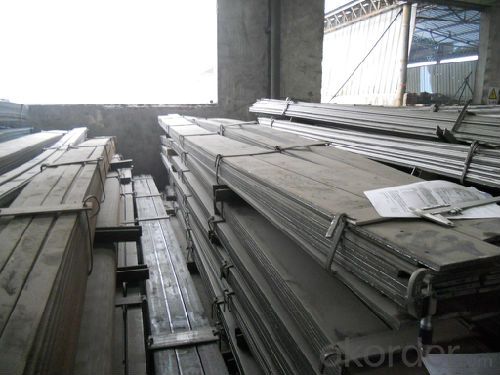
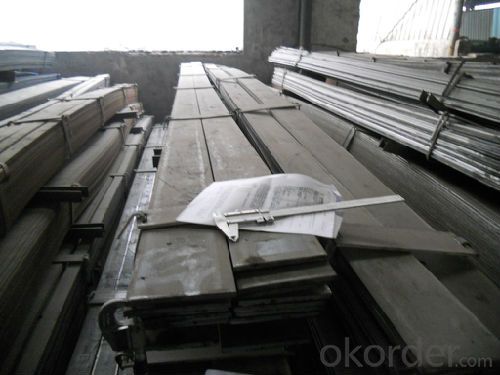
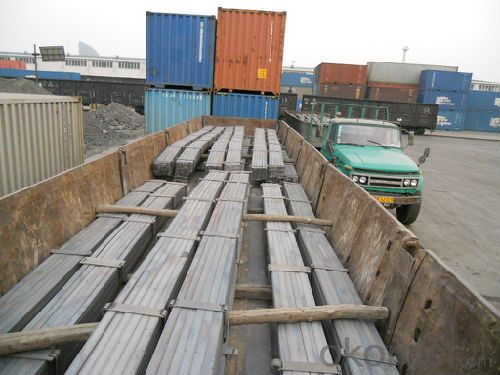
- Q:Are steel flat bars suitable for outdoor use?
- Indeed, steel flat bars prove to be fitting for outdoor utilization. The durability and corrosion resistance of steel render it an impeccable selection for outdoor purposes. In fact, steel flat bars exhibit the ability to endure severe weather conditions, such as rain, snow, and extreme temperatures, without succumbing to rust or deterioration. Consequently, they are frequently employed in construction, fencing, and various outdoor structures. Furthermore, to heighten their resistance to corrosion and prolong their lifespan, steel flat bars can be coated with protective finishes, such as galvanization or powder coating. Ultimately, steel flat bars emerge as a dependable and enduring choice for outdoor use.
- Q:What are the different machinability ratings for steel flat bars?
- The machinability ratings for steel flat bars can vary depending on the specific grade and composition of the steel. However, some commonly used machinability ratings for steel flat bars include AISI 1212 (100% rating), AISI 1112 (125% rating), and AISI 1045 (50% rating).
- Q:Are steel flat bars used in structural engineering?
- Yes, steel flat bars are commonly used in structural engineering. They are versatile and widely used for various applications such as beams, columns, braces, and connections in buildings, bridges, and other structures. Steel flat bars offer excellent strength and durability, making them an essential component in structural engineering projects.
- Q:Can steel flat bars be used in food processing industries?
- No, steel flat bars are not typically used in food processing industries as they can corrode over time and contaminate the food. Stainless steel is the preferred material due to its corrosion resistance and hygienic properties.
- Q:Friction coefficient of steel pipe and flat steel on roller table!
- Flat, refers to the width 12-300mm, thickness 4-60mm, cross section is rectangular in shape and with a blunt edge of steel. Flat steel can be finished steel, or can be used as the blank of welded pipe and thin slab for laminated sheet rolling. Main application: flat steel is used as a material, used for making iron, tools and machinery parts, and used as frame structures and escalators for buildings.
- Q:What is the load-bearing capacity of a steel flat bar?
- The load-bearing capacity of a steel flat bar depends on various factors such as the dimensions of the bar, the type and grade of steel used, and the specific application or use case. Generally, steel flat bars are known for their high strength and load-bearing capabilities. To determine the load-bearing capacity of a steel flat bar, engineers consider several factors including the thickness, width, and length of the bar, as well as the type of load it will be subjected to (such as static or dynamic loads). Additionally, the type of steel used and its mechanical properties, such as yield strength and tensile strength, play a significant role in determining the load-bearing capacity. To provide a more specific answer, it would be necessary to know the exact dimensions and properties of the steel flat bar in question, as well as the intended use and load requirements. Consulting engineering specifications, structural analysis, or professional advice would be necessary to determine the precise load-bearing capacity for a particular steel flat bar in a specific application.
- Q:How do you straighten bent steel flat bars?
- To straighten bent steel flat bars, you can use a combination of heat and force. First, heat the bent area using a torch until it becomes malleable. Then, apply force gradually using a hammer or a hydraulic press to straighten the bar. It is important to work slowly and carefully to avoid over-straightening or damaging the steel.
- Q:How do steel flat bars perform in high-vibration environments?
- Steel flat bars possess exceptional strength and durability, rendering them suitable for a wide array of applications. However, their performance may be affected in high-vibration settings. High-vibration environments pose a risk to steel flat bars as they are susceptible to fatigue failure resulting from the repetitive stress cycles triggered by vibrations. This gradual deterioration can eventually lead to cracking or even complete failure of the bars. To address these concerns, various measures can be implemented. Firstly, it is crucial to select a steel alloy that exhibits high resistance to fatigue and can endure the expected vibration levels in the given environment. Additionally, the design of the structure or system should take into account the potential for vibrations, ensuring that the flat bars are properly supported and reinforced to minimize stress concentrations. Furthermore, the installation and maintenance of steel flat bars in high-vibration environments play a significant role in ensuring their performance. Regular inspections should be carried out to promptly identify any signs of fatigue or damage, and necessary repairs or replacements should be promptly executed. In conclusion, although steel flat bars offer exceptional strength and durability, their performance may be compromised in high-vibration environments. However, by selecting the appropriate steel alloy, designing structures to minimize stress concentrations, and implementing proper installation and maintenance practices, the performance of steel flat bars in such environments can be enhanced.
- Q:How do you protect steel flat bars from chemical exposure?
- There are several measures available to protect steel flat bars from chemical exposure. 1. Applying a protective coating is a highly effective way to shield steel flat bars. Different types of coatings, such as epoxy, polyurethane, or zinc-based coatings, can create a barrier between the steel and the chemicals. Careful consideration should be given to selecting the appropriate coating based on the specific chemicals and their compatibility with the coating material. 2. Galvanizing the steel flat bars provides excellent protection against chemical exposure. This involves coating the steel with a layer of zinc, which acts as a sacrificial barrier. When in contact with chemicals, the zinc coating corrodes instead of the steel, preventing direct chemical attack. 3. Stainless steel flat bars, especially those made from corrosion-resistant grades like 316 or 304, offer excellent resistance to chemical exposure. Stainless steel contains a minimum of 10.5% chromium, which forms a protective oxide layer on its surface, preventing corrosion by most chemicals. 4. Proper storage of steel flat bars is crucial to minimize chemical exposure. The storage area should ideally be dry, well-ventilated, and kept away from corrosive substances. Additionally, proper stacking and separation of different materials can prevent chemical reactions and potential damage. 5. Regular inspection and maintenance are essential to ensure ongoing protection against chemical exposure. Promptly addressing any signs of coating damage or corrosion is important. Cleaning the surface using suitable methods and products can remove chemical residues and maintain the effectiveness of protective measures. It should be noted that the specific protective measures will vary depending on the type and concentration of chemicals the steel flat bars will encounter. Consulting corrosion and material experts or referring to industry standards and guidelines can provide tailored recommendations for protecting steel flat bars in specific chemical environments.
- Q:How do steel flat bars compare to other materials like aluminum or stainless steel?
- Steel flat bars have several advantages over other materials like aluminum or stainless steel. Firstly, steel is generally stronger and more durable than aluminum, making it ideal for heavy-duty applications where strength is a priority. Steel also has a higher tensile strength, making it less likely to bend or deform under pressure. In terms of cost, steel flat bars are usually more affordable than stainless steel. Stainless steel is known for its excellent corrosion resistance, but it comes at a higher price point. If corrosion resistance is not a primary concern, steel flat bars offer a cost-effective alternative without compromising on strength or durability. Steel flat bars are also highly versatile and can be easily welded, machined, or formed into various shapes and sizes. This versatility allows for a wide range of applications in industries such as construction, manufacturing, and automotive. However, it is important to note that stainless steel flat bars have their own unique advantages. Stainless steel offers superior resistance to corrosion, rust, and staining, making it ideal for applications in harsh environments or where hygiene is crucial, such as in food processing or medical equipment. On the other hand, aluminum flat bars have their own set of advantages as well. Aluminum is lightweight, non-magnetic, and has excellent thermal and electrical conductivity. It is commonly used in industries such as aerospace, automotive, and construction, where weight reduction and conductivity are important factors. In conclusion, steel flat bars offer a strong and cost-effective option for various applications. However, the choice between steel, aluminum, or stainless steel ultimately depends on the specific requirements of the project, including factors such as strength, corrosion resistance, cost, and conductivity.
1. Manufacturer Overview |
|
|---|---|
| Location | |
| Year Established | |
| Annual Output Value | |
| Main Markets | |
| Company Certifications | |
2. Manufacturer Certificates |
|
|---|---|
| a) Certification Name | |
| Range | |
| Reference | |
| Validity Period | |
3. Manufacturer Capability |
|
|---|---|
| a)Trade Capacity | |
| Nearest Port | |
| Export Percentage | |
| No.of Employees in Trade Department | |
| Language Spoken: | |
| b)Factory Information | |
| Factory Size: | |
| No. of Production Lines | |
| Contract Manufacturing | |
| Product Price Range | |
Send your message to us
Flat Steel A36 Q235 SS400 Slit Ms Carbon Mild Hot Rolled
- Loading Port:
- Tianjin
- Payment Terms:
- TT or LC
- Min Order Qty:
- 27 m.t.
- Supply Capability:
- 35000 m.t./month
OKorder Service Pledge
OKorder Financial Service
Similar products
New products
Hot products
Hot Searches
Related keywords

